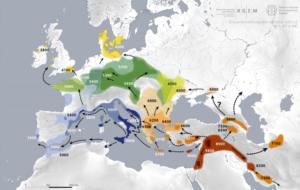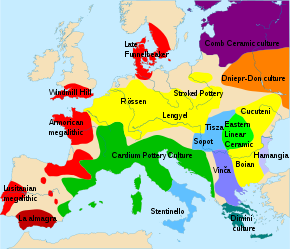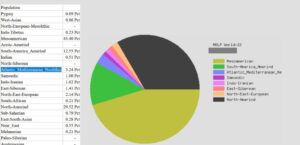Introduction
I. Brief overview of the Atlantic Mediterranean Neolithic ethnicity origin period
Atlantic Mediterranean neolithic, a period that exists 6000 to 4000 BCE. It is a period of transition from hunter-gatherer to settled agricultural people. In this time different cultures emerged around the Mediterranean basin. People started to live a settled life and cultivated various crops such as wheat barley, making pottery and taming animals.
II. Historical Context of Neolithic ethnicity
After coming across the term one question may arise in your mind, what is Neolithic ethnicity? The concept of Neolithic ethnicity arises from the era of 6000 to 4000 BC. It is the time just after the stone age when people started to settle their life through various practices.
So, what is the oldest Neolithic settlement to date in Europe? According to various archaeological studies, Franchthi Cave existed from 20th to 3rd millennium BC in Greece and is the first and oldest Neolithic settlement to date in Europe.
III. Identification of specific Neolithic ethnic groups and Ethnic identities
- After knowing the historical context, the Atlantic Mediterranean neolithic meaning must be clear to the readers. The one who brought the transition from hunting to settle farming practices.
- Among the lives of ancient people. But how to identify the specific Neolithic ethnic groups? Gedmatch is a source that helps to check the link between you and Neolithic ethnicity.

The above picture shows the Neolithic cultures in different parts of Europe around 4000–3500 BC.
This picture shows the neolithic sites in Europe map and the spread of farming practices in Europe 3800 BC.
Now, you must be wondering, is there any other name used to refer to the Neolithic era? Yes, there is one. What is the Neolithic age also known as? The Neolithic age is also known as the Stone Age. It was the final stage of cultural development and technology evolution of prehistoric people. It was known as stone age because at that time tools were made of stone, they were polished and grinded to use.
This era was marked by domestication of plants and animals, permanent villages were settled specially near the rivers, and the evolution of some crafts such as pottery and weaving were seen. After the stone age, the paleolithic period or era of chipped-stone tools started. Later it was preceded by the Bronze Age, the era of metal tools.
IV. Socioeconomic Structures
There are few social structures within the Neolithic people. These are of importance to those who belong to this group. Presently the Neolithic populations are divided into few individual Neolithic groups. These groups are used as reference to compare the DNA with on Gedmatch by using few means such as the Admixture Calculators. These groups are:
-
- Anatolia Neolithic
- Anatolian Neolithic
- Atlantic Mediterranean Neolithic
- Greek Neolithic
- Andronovo Eneolithic
- Afanasievo Eneolithic
- Samara Eneolithic
- Steppe Eneolithic
Importance of the Above Groups
- Few names among these groups can help to identify the places where they belong to. They are area specific groups and cover that particular area. The Greek Neolithic is one such group. It specifies the Neolithic Age in Greece.
- There are few names in the above list that are quite uncommon and regions related can not be identified from the name itself. The Anatolian Neolithic is one such name. Present day Anatolian Neolithic region in Turkey and Northern Syria.
- Some groups are termed as Eneolithic. The term “Eneolithic” refers to an ancient time also known as the Copper Age. This era started 9000 years ago. In this time copper was extensively used in tools, utensils, etc. This period was the “transition period” between the Neolithic Age and the Bronze Age. It was a neolithic revolution that acted as a bridge between ancient people and modern civilization.
- We the people of modern times are quite familiar with the Bronze Age. This age was a time period of ancient time, where bronze was extensively used in tools, utensils,etc. The Bronze Age had covered the areas of Ancient Egypt, the Shang Dynasty and Babylonia.
Challenges in Studying Neolithic Ethnicity
Studying Neolithic Ethnicity can also have some challenges and limitations. These problems may arise due to limited archaeological studies, material evidence, mixing of cultures and no written record present. Interpretation of ethnic identity from artifacts and practices may not be correct as these are not enough to reflect ethnicity of Neolithic Atlantic Mediterranean era. Moreover the complicated nature of various groups in history along with their dynamic interactions with the other neighboring groups may cause problems in defining ethnic boundaries.
- Neolithic DNA: What does it mean to have Neolithic DNA?
The term “Neolithic” DNA is somewhat an incorrect term to use. If we say Neolithic DNA , we might be wrong. Instead we may say that the DNA sample matches specific Neolithic population groups.
How to check to see if you have Neolithic in your DNA on Gedmatch? Here is an example. The following picture shows the result of Neolithic DNA of an individual. The above reserve shows that this individual’s DNA matches most of the indigenous North and South America ancestry. They also have Y-DNA haplogroups and Native American mtDNA. In the autosomal DNA test it can be seen that a small percentage of DNA matches certain populations of Europe, Africa and Asia.
-
Do We All Have Neolithic DNA?
To your surprise the answer is yes. We all have Neolithic DNA in a certain way. All the human beings who are living on this planet have their ancestors at some point who were present and alive during the Neolithic period somewhere on this planet. Thus, we all have a specific percentage of Neolithic DNA to an extent.
Future Research and Implications on Neolithic resources
-
What is Neolithic on Gedmatch?
In Gedmatch, the Neolithic period is also known as the new stone age which began around 12,000 years ago. There are certain admixture calculators present in Gedmatch which provide the result of your DNA and its link to Neolithic ancestry. Which Admixture Calculators Report Neolithic DNA? Now before choosing the best calculator you need to know that there are many calculators present in the side that give a report of a possible percentage similarity to the ancient Neolithic populations but it comes with a limitation.
These calculators are not able to cover every geographical location of the world. The Gedmatch admixture calculators cover a few Neolithic groups which are connected to the ancient DNA studies. These groups are Anatolia Neolithic, Anatolian Neolithic, Atlantic Mediterranean Neolithic, Greek Neolithic, Andronovo Eneolithic, Afanasievo Eneolithic, Samara Eneolithic, Steppe Eneolithic. - Specifically on Gedmatch there are three calculators available that show results on Neolithic populations and their DNA. These calculators are puntDNAL (puntDNAL K12 Ancient), MDLP Project (MDLP K11 Modern and MDLP World-22), GedrosiaDNA (Ancient Eurasia K6).
VII. Atlantic Mediterranean Neolithic Ethnicity Traits
- The Atlantic Mediterranean neolithic period had some different cultural traits. This period was marked by the inclusion of practicing agriculture pottery and making megalithic structures. Particular ethnic traits can be seen across various regions influencing the art, tools and different burial practices.
- Determining the Atlantic Mediterranean neolithic ethnicity facial features is quite challenging due to limited archaeological studies. Several factors such as genetic variation, climate, practices and adaptation to the environment would contribute to the various physical traits. Various archaeological studies have stated the people at that time had over face with defined facial features. The complexion was dark, eyes were brown or black and hair was black turning to gray. The size of feet and hands were small.
Read More:
- The Genealogy of Australian Ancestry DNA And Main Ethnic Groups in Australia
- Find Your Ethnicity From Hair?
- What is a Third Cousin Once Removed?
- What is Fifth Cousin Once Removed?
- What is Scandinavian DNA Ethnicity? | Viking Ancestry
- Who Are Black Dutch? Where Are they Located? Ethnicity And DNA
VIII. Conclusion
Atlantic Mediterranean Neolithic DNA comes from an era 6000 to 4000 BCE. The era marked a transition period between hunting and settled civilization. Gedmatch is a source that helps to check the link between you and Neolithic ethnicity.
There are few groups used as reference to compare the DNA with on Gedmatch by using few means such as the Admixture Calculators. Few admixture calculators are These calculators are puntDNAL (puntDNAL K12 Ancient), MDLP Project (MDLP K11 Modern and MDLP World-22), GedrosiaDNA (Ancient Eurasia K6). Few of these groups are known and reflect some areas but few are quite unfamiliar. But studying these DNA is not an easy task.
It comes with some challenges as well. Lack of archeological evidence and absence of written records block the path of studying Neolithic DNA. At some point we all have Neolithic DNA as at some point our ancestors belong to the Neolithic period. The Neolithic era traits are well reflected through their art, burial practices, pottery, tools, agricultural practices and more. These traits are visible in their physical features.


